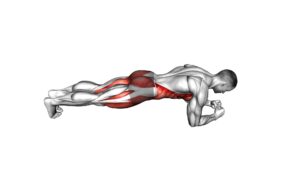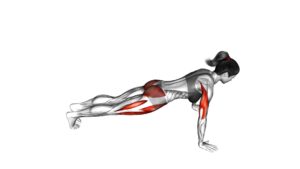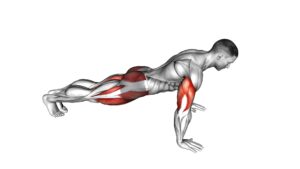Spider Plank (female) – Video Exercise Guide & Tips

Are you looking for a challenging and effective exercise to strengthen your core? Look no further than the spider plank!
Watch This Exercise Video
In this video exercise guide, we'll show you the proper form and technique for the spider plank, along with modifications for beginners and advanced variations for those looking to take it up a notch.
Avoid common mistakes and get ready to feel the burn with this dynamic core exercise.
Let's get started!
Key Takeaways
- Spider Plank targets multiple muscle groups simultaneously
- Spider Plank improves core strength and increases flexibility
- Spider Plank engages core muscles, shoulders, arms, and legs
- Spider Plank enhances stability and balance
Benefits of Spider Plank
One major benefit of Spider Plank is that it targets multiple muscle groups simultaneously, making it an efficient and effective exercise.
The Spider Plank is a variation of the traditional plank exercise that specifically focuses on improving core strength and increasing flexibility. When you perform the Spider Plank, you engage your core muscles, including the rectus abdominis, obliques, and transverse abdominis, as well as the muscles in your shoulders, arms, and legs.
This exercise requires you to maintain a stable and aligned body position while bringing your knees towards your elbows in a controlled manner. By doing so, you not only strengthen your core but also enhance your overall stability and balance.
Additionally, the Spider Plank helps to improve flexibility in the hips and lower back as you stretch and move your legs during the exercise. This combination of core strength and increased flexibility can benefit your overall fitness and performance in various activities, such as sports, yoga, and daily movements.
Incorporating Spider Plank into your workout routine can help you achieve a stronger core and improved flexibility efficiently.
Proper Form and Technique
To ensure proper form and technique when performing the Spider Plank exercise, it's important that you maintain a stable and aligned body position throughout the movement. Here are some tips to help you achieve optimal form:
- Start in a high plank position with your hands directly under your shoulders and your body in a straight line from head to toe.
- Engage your core muscles by drawing your belly button in towards your spine.
- As you bring your knee towards your elbow, be sure to keep your hips level and avoid any twisting or sagging in the lower back.
- Keep your shoulders relaxed and away from your ears, maintaining a strong and stable upper body position.
Now, let's address some common misconceptions about the Spider Plank exercise. One misconception is that this exercise is only suitable for advanced fitness levels. However, by modifying the movement and starting with a shorter range of motion, beginners can also benefit from this exercise.
Another misconception is that the Spider Plank only targets the abs. While it's true that the exercise primarily targets the core muscles, it also engages the shoulders, chest, and hips.
If you're looking for alternative exercises that target similar muscle groups, you can try mountain climbers or knee-to-elbow planks. Both of these exercises involve similar movements and engage the core muscles effectively. Remember, proper form and technique are key to maximizing the benefits and avoiding injury during any exercise.
Modifications for Beginners
Are you wondering how to modify the Spider Plank exercise for beginners? If you're just starting out, it's important to make modifications to ensure your safety and prevent injuries. Here are some beginner modifications and safety precautions to keep in mind.
First, you can start by performing the exercise on your knees instead of your toes. This reduces the amount of body weight you have to support and makes it easier to maintain proper form. As you build strength and confidence, you can gradually progress to the full Spider Plank position.
Another modification is to place your hands on an elevated surface, such as a bench or step, instead of on the floor. This decreases the intensity of the exercise and allows you to focus on mastering the movement pattern.
Remember to engage your core muscles throughout the exercise and keep your back in a neutral position. Avoid sagging or arching your back, as this can strain your lower back and lead to discomfort or injury.
It's also important to listen to your body and take breaks when needed. If you feel any pain or excessive discomfort, stop the exercise and consult with a fitness professional or healthcare provider.
Advanced Variations and Progressions
Looking to take your Spider Plank exercise to the next level? Here are some advanced modifications and progressions that you can try to challenge yourself even further:
- Weighted Spider Plank: Incorporate equipment such as a weight plate or dumbbells to add resistance to your Spider Plank. Place the weight on your back or shoulders to increase the intensity of the exercise.
- Spider Plank with Leg Lift: While holding the Spider Plank position, lift one leg off the ground and extend it straight behind you. Hold for a few seconds and then lower it back down. Repeat on the other leg. This variation targets your glutes and hamstrings even more.
- Spider Plank with Knee Tuck: Instead of extending your leg straight behind you, bring your knee towards your chest while maintaining the Spider Plank position. Alternate between legs to engage your core and challenge your stability.
- Spider Plank with Push-up: Perform a push-up while in the Spider Plank position. This combination exercise works your upper body, core, and lower body all at once, making it a full-body challenge.
Incorporating these advanced variations and progressions into your Spider Plank routine will help you continue to build strength, improve stability, and take your workout to new heights. Remember to always maintain proper form and listen to your body to prevent any injuries.
Common Mistakes to Avoid
Avoid these common mistakes when performing the Spider Plank exercise to ensure optimal results and prevent injury.
Proper alignment is crucial in achieving the full benefits of this exercise. One common mistake to avoid is sagging your hips. When your hips drop, your core isn't engaged properly, and you put unnecessary strain on your lower back. To prevent this, focus on keeping your body in a straight line from your head to your heels.
Another mistake to steer clear of is lifting your hips too high. This reduces the engagement of your core and shifts the focus to your shoulders and arms. To maintain proper alignment, aim to keep your hips in line with your shoulders.
Lastly, rushing through the exercise is a common mistake that can compromise your form and effectiveness. Instead, take your time and focus on maintaining the correct alignment throughout each repetition.
Frequently Asked Questions
How Many Calories Can Be Burned by Doing Spider Plank?
Spider Plank is a great exercise for building core strength. It engages multiple muscle groups, including your abs, obliques, and lower back.
By incorporating this exercise into your routine, you can burn calories and improve your overall fitness.
Spider Plank also offers variations that can make your workout more challenging, such as adding a knee tuck or performing the exercise on an unstable surface.
These variations can further enhance your calorie burn and help you reach your fitness goals.
What Are the Muscles Targeted by Spider Plank?
Spider Plank is a great exercise for targeting multiple muscles in your body. It primarily focuses on your core muscles, such as the rectus abdominis and obliques, helping to improve overall core strength.
In addition, Spider Plank also engages your shoulders, chest, and triceps, providing a full-body workout. By incorporating this exercise into your routine, you can benefit from increased stability, improved posture, and enhanced muscle definition.
Remember to avoid common mistakes, like sagging your hips or letting your elbows flare out, for optimal results.
How Long Should I Hold the Spider Plank Position?
To determine the optimal duration for holding the spider plank position, consider your current fitness level and goals. Beginners may start with shorter intervals, such as 10-15 seconds, gradually increasing as strength improves.
Holding the plank for 30-60 seconds is a common goal. Modifying the spider plank by using a stability ball or performing it on your knees can make it more manageable for beginners.
Incorporating spider plank into your workout routine can improve core strength, stability, and overall body control.
Can Spider Plank Help Improve Flexibility?
Spider plank is a great exercise for improving flexibility. It works your core muscles and helps to increase your range of motion. By engaging your abs and stabilizing your body, spider plank challenges your flexibility and improves your overall strength.
There are also variations of spider plank that you can incorporate into your routine to further challenge yourself and target different muscle groups. These variations are perfect for those at advanced fitness levels looking to take their workout to the next level.
Is It Necessary to Warm up Before Performing Spider Plank?
It is important to warm up before performing spider plank. Warming up helps prepare your muscles and joints for the exercise, reducing the risk of injury.
Proper form is also crucial in spider plank to ensure maximum effectiveness and prevent strain on your body.
If you're looking for alternatives to warm up, you can try dynamic stretches, light cardio exercises, or other core strengthening exercises.
Remember to always prioritize safety and listen to your body during your workout routine.
Conclusion
In conclusion, the spider plank exercise offers numerous benefits, including improved core strength and stability. By maintaining proper form and technique, individuals can maximize the effectiveness of this exercise.
Beginners can modify the spider plank to suit their fitness level, while advanced variations and progressions provide a challenge for those seeking more intensity. It's important to avoid common mistakes to ensure a safe and effective workout.
Incorporating the spider plank into your exercise routine can help you achieve your fitness goals.

Author
Years ago, the spark of my life’s passion ignited in my mind the moment I stepped into the local gym for the first time. The inaugural bead of perspiration, the initial endeavor, the very first surge of endorphins, and a sense of pride that washed over me post-workout marked the beginning of my deep-seated interest in strength sports, fitness, and sports nutrition. This very curiosity blossomed rapidly into a profound fascination, propelling me to earn a Master’s degree in Physical Education from the Academy of Physical Education in Krakow, followed by a Sports Manager diploma from the Jagiellonian University. My journey of growth led me to gain more specialized qualifications, such as being a certified personal trainer with a focus on sports dietetics, a lifeguard, and an instructor for wellness and corrective gymnastics. Theoretical knowledge paired seamlessly with practical experience, reinforcing my belief that the transformation of individuals under my guidance was also a reflection of my personal growth. This belief holds true even today. Each day, I strive to push the boundaries and explore new realms. These realms gently elevate me to greater heights. The unique combination of passion for my field and the continuous quest for growth fuels my drive to break new ground.







